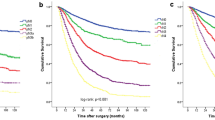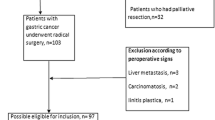Abstract
Background
The purpose of this study was to clarify the outcome of the ratio of the metastatic lymph nodes (RML) in gastric cancer patients.
Methods
The postoperative survival of 650 patients with gastric cancer who underwent D2 curative gastrectomy was analyzed with regard to the RML. The location, number, and RML in the N1 station and in all (N1 and N2) stations were analyzed. These data were compared from the viewpoints of staging accuracy and patient survival.
Results
The RML was classified as follows: RML 0, no involvement; RML 1, 0 to .1; RML 2, .1 to .25; and RML 3, ≥.25. The 5-year survival rates stratified by RML were RML 0, 86%; RML 1, 68%; RML 2, 35%; and RML 3, 16%. Cox model identified all methods of classifying lymph node metastases as independent prognostic indicators in each calculation. However, a second Cox regression revealed that RML was the only independent prognostic factor among the three methods (P<.001). Stage migration was present in 35 cases (15%) when the number was considered. However, only 15 cases (7%) were underdiagnosed when RML was used.
Conclusions
RML is a useful classification of patients with gastric cancer. It may prevent the phenomenon of stage migration.
Similar content being viewed by others
References
Maruyama K, Gunven P, Okabayashi K, Sasako M, Kinoshita T. Lymph node metastases of gastric cancer—general pattern in 1931 patients.Ann Surg 1989;210:596–602.
Kampschoer GHM, Maruyama K, Van de Velde CJ, Sasako M, Kinoshita T, Okabayashi K. Computer analysis in making preoperative decisions: a rational approach to lymph node dissection in gastric cancer patients.Br J Surg 1989;76:905–8.
Okusa T, Nakane Y, Boku T, Takada H, Yamamura M, Hioki K, Yamamoto M. Quantitative analysis of nodal involvement with respect to survival rate after curative gastrectomy for carcinoma.Surg Gynecol Obstet 1990;170:488–94.
Shiu MH, Perrotti M, Brennan MF. Adenocarcinoma of the stomach: a multivariate analysis of clinical, pathologic and treatment factors.Hepatogastroenterology 1989;36:7–12.
Jaehne J, Meyer HJ, Maschek H, Geerlings H, Bruns E, Pichlmayr R. Lymphadenectomy in gastric adenocarcinoma: a prospective and prognostic study.Arch Surg 1992;127:290–4.
Adachi Y, Kamakura T, Mori M, Baba H, Maehara Y, Sugimachi K. Prognostic significance of the number of positive lymph nodes in gastric carcinoma.Br J Surg 1994;81:414–6.
Yu W, Choi GS, Whang I, Suh S. Comparison of five systems for staging lymph node metastasis in gastric cancer.Br J Surg 1997; 84:1305–9.
Roder JG, Busch R, Stein HJ, Fink U, Siewert R. Ratio of invaded to removed lymph nodes as a predictor of survival in squamous cell carcinoma of the oesophagus.Br J Surg 1994;81:410–3.
Siewert JR, Bottcher K, Stein HJ, Roder JD. Relevant prognostic factors in gastric cancer: ten-year results of the German Gastric Cancer Study.Ann Surg 1998;228:449–61.
Kwon SJ, Kim GS. Prognostic significance of lymph node metastasis in advanced carcinoma of the stomach.Br J Surg 1996;83:1600–3.
Japanese Gastric Cancer Association. Japanese Classification of Gastric Carcinoma—2nd English Edition.Gastric Cancer 1998;1:10–24.
Sobin LH, Wittekind CH. International Union Against Cancer (UICC). TNM Classification of Malignant Tumours. 5th ed. New York: Wiley, 1997.
Bonder BE. Will Rogers and gastric carcinoma (letter).Arch Surg 1988;123:1023–4.
Irvin TT, Bridger JE. Gastric cancer: an audit of 122 consecutive cases and results of R1 gastrectomy.Br J Surg 1988;75:106–9.
Herber G, Teichman RK, Kramling HJ, Gunther B. Results of resection for carcinoma of the stomach: the European experience.World J Surg 1988;12:374–81.
Kaplan EL, Meier P. Nonparametric estimation for incomplete observations.J Am Stat Assoc 1958;53:457–81.
Kalbfleisch JD, Prentice RL.The Statistical Analysis of Failure Time Data. New York: Wiley, 1980.
Cox DR. Regression models and life tables.J R Stat Soc B 1972;34:187–220.
Bozzetti F, Bonfanti G, Morabito T, et al. A multifactorial approach for the prognosis of patients with carcinoma of the stomach after curative resection.Surg Gynecol Obstet 1986;162:229–34.
Okajima K. Prognostic factors of gastric cancer patients—a study by univariate and multivariate analysis (in Japanese, with English abstract).Jpn J Gastroenterol Surg 1997;30:700–11.
Dent DM, Madden MV, Price SK. Randomized comparison of R1 and R2 gastrectomy for gastric carcinoma.Br J Surg 1988;75:110–2.
Miwa K, Miyazaki I, Sahara H, et al. Rationale for extensive lymphadenectomy in early gastric carcinoma.Br J Cancer 1995; 72:1518–24.
Bonenkamp JJ, Hermans J, Sasako M, van de Velde CJ. Extended lymph-node dissection for gastric cancer. Dutch Gastric Cancer Group.N Engl J Med 1999;340:908–14.
Cuschieri A, Fayers P, Fielding J, et al. Postoperative morbidity and mortality after D1 and D2 resections for gastric cancer: preliminary results of the MRC randomized controlled surgical trial.Lancet 1996;347:995–9.
Sasako M, McCulloch P, Kinoshita T, Maruyama K. New method to evaluate the therapeutic value of lymph node dissection for gastric cancer.Br J Surg 1995;82:346–51.
Aiko T, Sasako M. The new Japanese Classification of Gastric Carcinoma: points to be revised.Gastric Cancer 1998;1:25–30.
Msika S, Chastang C, Houry S, Lacaine F, Huguier M. Lymph node involvement as the only prognostic factor in curative resected gastric carcinoma: a multivariate analysis.World J Surg 1989;13:118–23.
Baba H, Korenaga D, Okamura T, Saito A, Sugimachi K. Prognostic factors in gastric cancer with serosal invasion: univariate and multivariate analyses.Arch Surg 1989;124:1061–4.
Roukos DH, Kappas AM, Encke A. Extensive lymph node dissection in gastric cancer: is it of therapeutic value (editorial)?Cancer Treat Rev 1996;22:247–52.
Bunt AMG, Hermans J, Smit VTHBM, van de Velde CJH, Fleuren GJ, Brujin JA. Surgical/pathologic-stage migration confounds comparisons of gastric cancer survival rates between Japan and Western countries.J Clin Oncol 1995;13:19–25.
Bunt AMG, Hogendoorn PCW, van de Velde CJH, Brujin JA, Hermans J. Lymph node staging standards in gastric cancer.J Clin Oncol 1995;13:2309–16.
Noguchi Y, Imada T, Matsumoto A, Coit DG, Brennan MF. Radical surgery for gastric cancer. A review of the Japanese experience.Cancer 1989;64:2053–62.
Siewert JR, Bottcher K, Roder JD, Busch R, Hermanek P, Meyer HJ. Prognostic relevance of systematic lymph node dissection in gastric carcinoma. The German Gastric Carcinoma Study Group.Br J Surg 1993;80:1015–8.
Wagner PK, Ramaswamy A, Schmitz-Moormann P, Rothmund M. Lymph node counts in the upper abdomen: anatomical basis for lymphadenectomy in gastric cancer.Br J Surg 1991;78:825–7.
Hammond EH, Henson DE. The role of pathologists in cancer patient staging. Cancer Committee (editorial).Am J Clin Pathol 1995;103:679–80.
Noda N, Sasako M, Yamaguchi N, Nakanishi Y. Ignoring small lymph nodes can be a major cause of staging error in gastric cancer.Br J Surg 1998;85:831–4.
Bunt AMG, Hermans J, Boon MC, et al. Evaluation of the extent of lymphadenectomy in a randomized trial of Western- versus Japanese-type surgery in gastric cancer.J Clin Oncol 1994;12:417–22.
Author information
Authors and Affiliations
Corresponding author
Rights and permissions
About this article
Cite this article
Bando, E., Yonemura, Y., Taniguchi, K. et al. Outcome of ratio of lymph node metastasis in gastric carcinoma. Annals of Surgical Oncology 9, 775–784 (2002). https://doi.org/10.1007/BF02574500
Received:
Accepted:
Issue Date:
DOI: https://doi.org/10.1007/BF02574500




